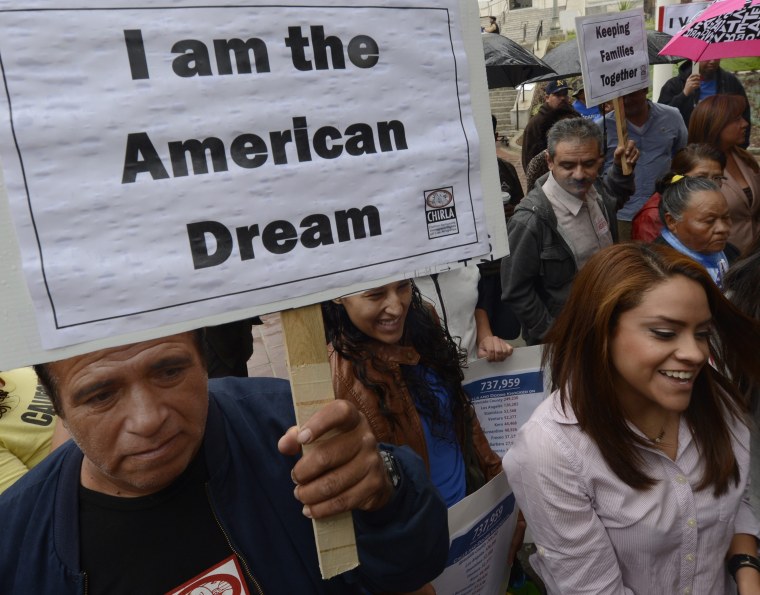A bipartisan group of lawmakers has reached a consensus on how to overhaul the nation’s immigration system, announcing Monday they hope to provide a pathway for citizenship for the 11 million illegal immigrants in the country.
"This will be the year Congress finally gets it done," Sen. Chuck Schumer of New York said at a press conference. The Democrat added that "the politics on this issue have been turned upside down" and now "there's more political risk in opposing immigration reform than supporting it."
The senators' deal helps give some momentum to President Barack Obama’s push for immigration reform, and suggests that after the GOP got thumped in the 2012 election (71% of Latinos voted for Obama, versus 27% for Mitt Romney) Republicans understand the imperative of appealing to Latinos.
In addition to Schumer, the senators pushing for reform include Democrats Dick Durbin, Robert Mendendez, and Michael Bennet, along with Republicans John McCain, Marco Rubio, Jeff Flake and Lindsey Graham. They said the goal is to have immigration legislation pass by late spring or summer and have outlined four major goals.
* Providing a means for citizenship to immigrants who are already here (which is contingent on securing the nation’s border and more efficiently tracking those here on visas already).
*Awarding green cards to immigrants who obtain advanced degrees from American universities.
*Coming up with an employment verification system to make sure employers do not hire those people who are in the country illegally
*Letting in more low-skill workers and allowing employers to hire immigrants if they can effectively show they couldn’t recruit a U.S. citizen with the same skills needed
While immigration advocates and non-profits are hailing this development, several are remaining somewhat skeptical.
“I think this is really important progress” Ben Johnson, executive director of the American Immigration Council, told msnbc.com, noting there doesn’t seem to be much sniping yet between Democrats and Republicans and Congress and the White House.
He said there were concerns about the details, especially with border security. The path to citizenship is contingent on increasing border security.
In the past, lawmakers have been “woefully ineffective at defining what border security means,” said Johnson. He also said he was concerned about overhauling the country’s Green Card system, which has been “clogged and dysfunctional for 20 years."
“The devil’s in the details. There’s still a lot of work to be done,” he said.
The American Civil Liberties Union argues that there are provisions in the plan that will endanger citizens' civil liberties and will increase unwarranted wasteful spending on border security.
On the call to use an electronic verification system, Chris Calabrese, ACLU legislative counsel, said it was “an expensive electronic employment-verification system, is a thinly-disguised national ID requirement that undermines the privacy of every American worker while imposing new burdens on businesses. Mandatory E-Verify would not only lead to discrimination against those who look or sound “foreign,” but also increase the risk of identity theft and make it harder to get a job.”
And Vicki B. Guabeca, director of the ACLU’s New Mexico Regional Center for Border Rights, said the plan is encouraging but should not be “contingent upon more border enforcement."
“Already, there are almost 10 Border Patrol agents per mile along the U.S.-Mexico border—if lined up from San Diego to Brownsville they could see each other. This is on top of all the other federal agents deployed at the border, more than 650 miles of border fencing, and drones patrolling our skies, among other technologies,” she said in a statement.
“Since 2007, we have seen border enforcement on steroids. The fact is, there is a 40-year low in migrant apprehensions at the border, and border communities are safer than ever. Reform must downsize wasteful and unnecessary spending on the border,” Guabeca added.
Similarly, Marielena Hincapie, executive director of the National Immigration Law Center said in a statement to msnbc.com that “the road to citizenship should not be contingent upon more militarization of the border and increased detention and deportation initiatives.”
The AFL-CIO, the largest federation of unions in the United States, is concerned that making the citizenship path consistent on proof of employment at the time enforcement measures are going on could be problematic.
“Depending on implementation, the principles could potentially exclude millions of workers—those who are for our children and our elderly, mow our lawns and repair our homes, drive taxis—who cannot prove employment because they have been forced to work off the clock or have no employer by virture of being independent contractors,” the organization said in a statement.
President Obama is scheduled to layout his plan, which is likely to be similar to the Senate’s vision, in Nevada on Tuesday.
